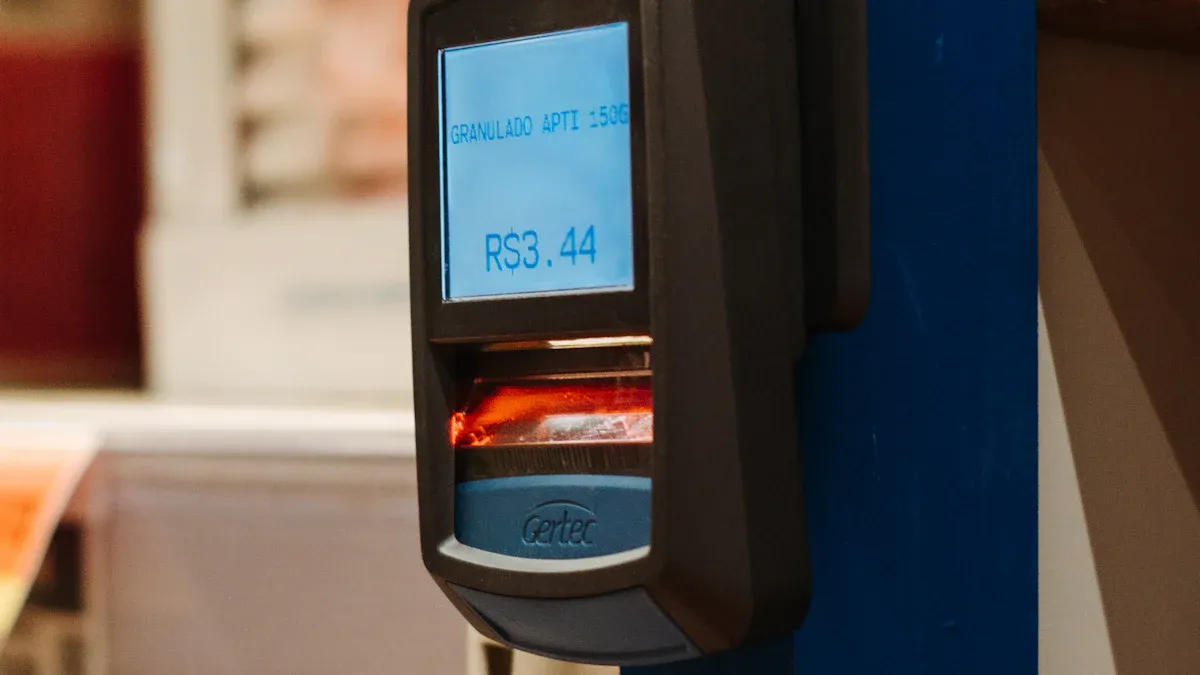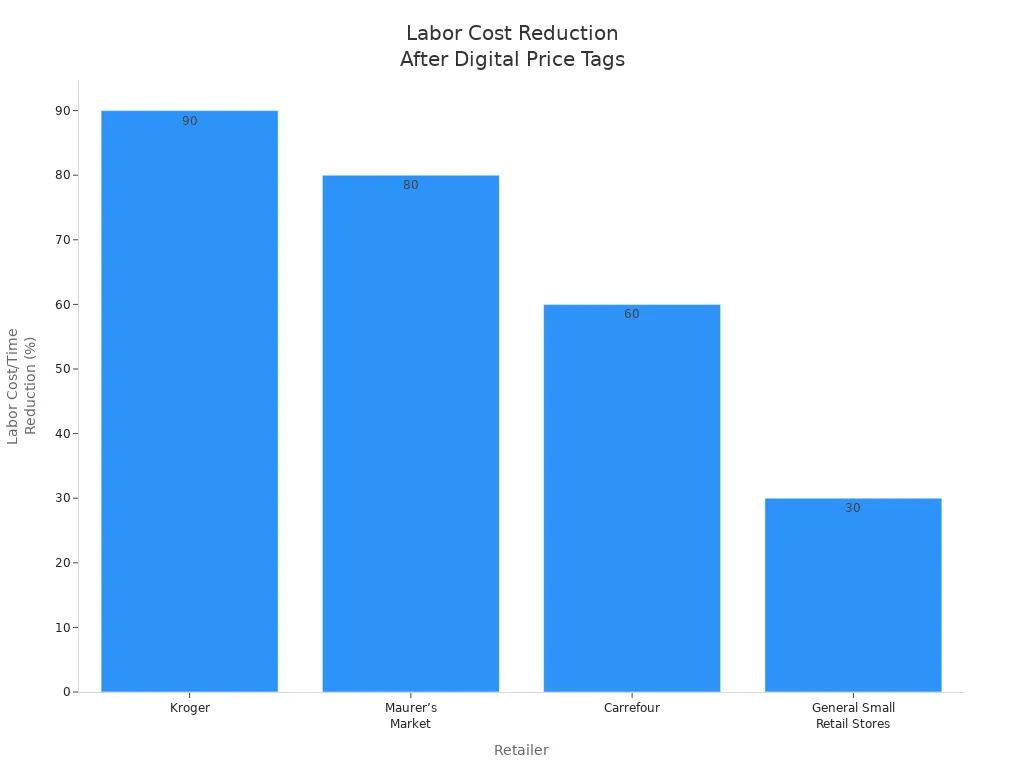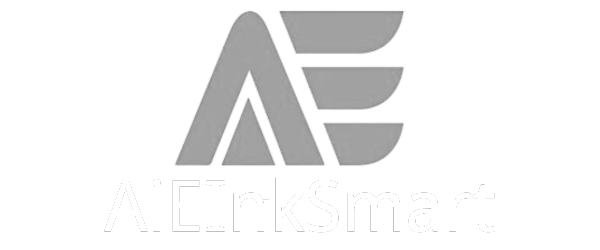
You can transform your retail operations with digital price tags, especially when managing multiple locations. Digital price tags, including Electronic Shelf Labels and ESL Price Tag solutions, allow you to update prices in real-time, minimizing errors and ensuring consistency for every customer. With digital systems like ESL Gateway AP and Esl Retail, you gain the benefits of centralized control and real-time updates. Retailers such as Walmart and Carrefour have seen efficiency gains and reduced paper waste. These benefits extend to improved inventory management and a better customer experience.
Digital Price Tags in Multi-Store Retail

What Are Digital Price Tags?
You use digital price tags to display product prices and information directly on store shelves. These tags replace traditional paper labels with electronic displays, such as e-paper or LCD screens. Digital price tags allow you to update prices instantly and remotely, which helps you maintain accuracy and consistency across all your stores. You can show not only the price but also product details, promotions, and even QR codes for more information. Retailers in sectors like grocery, electronics, fashion, and home improvement often rely on digital price tags to streamline operations and improve the customer experience.
Some of the most common use cases for digital price tags in multi-store retail include:
- Real-time price updates for consistent pricing across locations
- Dynamic pricing strategies based on demand or inventory
- Quick promotion management and discount launches
- Displaying detailed product information, such as reviews or nutritional facts
- Integration with POS and inventory systems for better stock control
- Enhancing customer engagement with interactive shelf labels
- Reducing manual labor and operational costs
- Preventing unauthorized price changes
- Supporting sustainability by reducing paper waste
How Digital Price Tags Operate Across Multiple Locations
You manage digital price tags across multiple stores using centralized software. This system connects to your retail management platform, allowing you to control pricing and product information from one location. When you update a price or product detail, the system pushes these changes wirelessly to every store. Technologies like Wi-Fi, Bluetooth Low Energy, and NFC ensure that updates reach each digital price tag in real time.
The process typically works as follows:
- Your headquarters updates pricing or product data in the central management system.
- The system detects changes and sends updates wirelessly to digital price tags in all stores.
- Store staff can monitor updates through a web portal and schedule or trigger updates as needed.
- Integration with POS and inventory systems ensures that shelf prices always match checkout prices.
This setup eliminates manual errors and ensures that every store displays the correct price and product information at all times.
Key Components of a Multi-Store Digital Price Tag System
A robust digital price tag system for multi-store management includes several essential hardware and software components. You need to understand these elements to ensure smooth operation and scalability.
| Component Category | Key Elements & Details |
|---|---|
| Hardware Components | – Digital Shelf Labels: e-paper, LCD, or graphic displays for pricing and promotions |
| – Wireless Connectivity: Wi-Fi, Bluetooth Low Energy, proprietary RF for reliable updates | |
| – Mounting Solutions: clips, magnets, or rails for easy installation | |
| – Power Sources: battery-powered, hardwired, or solar-powered options | |
| Software Components | – Retail Management Systems: centralized price and product control |
| – POS Integration: syncs shelf and checkout pricing | |
| – Middleware: bridges systems and prevents update delays | |
| – AI-Powered Dynamic Pricing: adjusts prices based on demand or stock | |
| – Security: encryption, authentication, and failover systems | |
| Infrastructure & Network | – Centralized data management and dedicated wireless networks |
| – Security layers to prevent unauthorized access |
Tip: Investing in a comprehensive digital price tag system helps you maintain pricing accuracy, streamline management, and support future growth across all your retail locations.
Centralized Pricing Control with Digital Price Tags
Centralized pricing control stands as one of the most powerful advantages you gain when you implement digital price tags across multiple retail locations. This approach allows you to manage prices, promotions, and product information from a single platform, ensuring that every store reflects the same standards of accuracy and efficiency. You can streamline workflows, reduce manual effort, and deliver a consistent customer experience, all while improving your operational efficiency.
Unified Price Management Across All Stores
When you use digital price tags, you unlock unified price management capabilities that transform how you handle pricing across your retail chain. You no longer need to rely on manual updates or fragmented systems. Instead, you gain a centralized dashboard that gives you complete visibility and control over every price and promotional offer in your stores.
Remote Price Setting and Updates
With digital price tags, you can set and update prices remotely for every location in your network. This capability eliminates the need for staff to manually change paper tags, which often leads to errors and delays. You simply adjust the price in your central system, and the update appears instantly on every shelf, regardless of store location.
- You save time and reduce labor costs by automating routine price changes.
- You minimize errors, as digital systems ensure that the price displayed on the shelf always matches the checkout and online prices.
- You can respond quickly to market trends, competitor moves, or inventory changes by adjusting prices in real time.
Note: Centralized price management enables you to launch promotional offers or adjust prices chain-wide within minutes, giving you a competitive edge in fast-moving retail environments.
Managing Promotions and Discounts Chain-Wide
Digital price tags make it easy to manage promotions and discounts across all your stores. You can schedule promotional offers, flash sales, or seasonal discounts from your central dashboard, ensuring every location participates at the same time.
- You maintain consistency in promotional pricing, which builds trust with your customers.
- You avoid the risk of outdated or conflicting offers, as digital tags update instantly.
- You can track the effectiveness of each promotion through real-time analytics, helping you optimize future campaigns.
This level of control supports faster go-to-market for new offers and ensures that your brand delivers a seamless experience, no matter where your customers shop.
Ensuring Consistency in Pricing and Product Information
Consistency in pricing and product information is critical for building customer trust and maintaining your brand reputation. Digital price tags help you overcome the challenges of managing complex product assortments and pricing structures across multiple locations.
Eliminating Price Discrepancies Between Locations
Manual price updates often lead to discrepancies between stores, which can frustrate customers and damage your brand. Digital price tags solve this problem by synchronizing every price change across all locations in real time.
- You prevent errors caused by fragmented or manual processes.
- You ensure that every customer sees the same price for the same product, regardless of store.
- You reduce the risk of legal or compliance issues related to inconsistent pricing.
Automated product linking and AI-powered algorithms further enhance pricing accuracy by grouping related products and applying consistent pricing rules. This approach helps you maintain the right price gaps between variants, brands, or sizes, supporting smarter margin management.
Synchronizing Product Data Across Stores
Digital price tags do more than display prices. They also synchronize product information, such as descriptions, stock levels, and promotional offers, across all your stores.
- You eliminate the risk of outdated or incorrect product details on the shelf.
- You provide customers with accurate, up-to-date information, improving their shopping experience.
- You streamline catalog management, reducing duplicated efforts and saving time.
By integrating digital price tags with your POS and inventory systems, you ensure that every store operates with the same data. This synchronization supports agile pricing strategies, enables quick adjustments for promotional offers, and enhances overall pricing accuracy.
Tip: Consistent pricing and product information across all locations not only improves operational efficiency but also strengthens your brand’s reliability in the eyes of your customers.
Real-Time Synchronization and Updates via Digital Price Tags

Instantaneous Price Changes Across Locations
You gain a significant advantage when you use digital price tags for your retail chain. Real-time synchronization allows you to update prices instantly across all your stores. This capability ensures that every location reflects the latest pricing, promotions, and real-time offers without delay.
Rapid Response to Market Trends
You can respond to market trends with unmatched speed. Digital price tags let you adjust prices in real time, so you never miss an opportunity to stay competitive. For example, if a competitor lowers their price or a product’s demand spikes, you can react immediately. Digital systems enable you to implement thousands of price changes at once, across every store, with just a few clicks from your central dashboard. Manual price changes, in contrast, require hours or even days and often lead to inconsistencies.
Digital price tags use electronic paper or LCD displays connected through a local network. This setup allows you to update prices automatically and simultaneously across thousands of displays. You eliminate the need for manual replacement of paper labels, making your pricing strategy much faster and more efficient.
Coordinating Flash Sales and Promotions
You can launch flash sales and promotions chain-wide with precision. Digital price tags ensure that every store starts and ends a promotion at the exact same time. This coordination builds excitement and trust among your customers, who know they will find the same price and offers at any location. Real-time updates also allow you to adjust or end promotions instantly if inventory runs low or market conditions change.
- Instant, real-time price changes across all locations
- Thousands of price changes executed simultaneously
- Automation eliminates labor-intensive manual updates
- Store managers adjust prices remotely for consistent pricing
Reducing Manual Errors and Outdated Pricing
Digital price tags help you minimize errors and keep your pricing accurate. Real-time synchronization with your POS and inventory systems ensures that shelf prices always match checkout prices.
Minimizing Human Intervention
You reduce the need for manual labor when you implement digital price tags. Automation handles routine price changes, so your staff can focus on customer service. This shift not only saves time but also reduces the risk of mistakes that come from manual updates.
- Digital price tags synchronize prices in real time with your point-of-sale system, eliminating errors like missed labels or incorrect entries.
- Studies show a 58% decrease in pricing and inventory marking mistakes.
- You see an 80% reduction in labor costs related to manual price updates.
Preventing Pricing Inaccuracies
You maintain high pricing accuracy with digital solutions. Real-time updates prevent discrepancies between shelf and checkout prices, which often frustrate customers. Automated logging of every price change enhances accountability and transparency.
| Evidence Aspect | Supporting Details |
|---|---|
| Pricing Error Reduction | Real-time synchronization reduces pricing errors by 60%. Automation decreases human errors by 58%. |
| Speed of Price Updates | Centralized wireless connection enables instant price changes across all stores. |
| Retailer Case Studies | Retailers report faster product rollouts and improved pricing accuracy after adopting digital price tags. |
| Integration Benefits | Integration with inventory and POS systems ensures prices reflect real-time stock and market conditions. |
| Audit and Transparency | Automated logging of every price change enhances accountability, reducing errors and disputes. |
| Customer Trust | Accurate shelf prices matching checkout prices build shopper confidence. |
You build customer trust by ensuring that your pricing remains consistent and accurate. Digital price tags support your ability to deliver real-time offers and maintain a seamless shopping experience across every location.
Operational Efficiency Gains from Digital Price Tags
Streamlining Store Operations
Digital price tags transform your store operations by automating routine tasks and improving overall efficiency. You can manage thousands of price changes instantly, which helps you respond quickly to market shifts and customer preferences. This automation reduces manual work and ensures that every shelf displays the correct price at all times.
Automating Routine Price Changes
You no longer need to rely on staff to update paper tags by hand. Digital price tags allow you to automate routine price changes across all your locations. With a centralized system, you can push new prices to every store in seconds. This process eliminates errors and ensures that your pricing remains accurate and up to date.
- Electronic shelf labels enable real-time price changes, letting you react to market trends immediately.
- You can launch promotions or adjust prices for flash sales without delay.
- Integration with inventory systems provides real-time stock data, helping you avoid overstocking or running out of products.
Tip: Automating price updates not only saves time but also improves your store’s operational efficiency, making your business more agile and competitive.
Freeing Up Staff for Customer Service
When you automate price changes, your staff can focus on delivering better customer service. Employees spend less time on repetitive tasks and more time helping customers, restocking shelves, and maintaining product displays. This shift leads to a more engaging shopping experience and higher customer satisfaction.
- Digital price tags display detailed product information, promotions, and prices directly on the shelf, reducing the need for staff intervention.
- Real-time updates ensure that customers always see the latest price and offers, building trust and loyalty.
Lowering Labor Costs Across Multiple Stores
Digital price tags deliver significant cost savings by reducing the time and resources needed for price management. You can see measurable benefits in both labor costs and staff productivity.
Reducing Time Spent on Price Tagging
Retailers who switch to digital price tags report dramatic reductions in the time spent updating prices. For example, Kroger reduced repricing time from two weeks to just five minutes, achieving up to a 90% reduction in labor costs for price label changes. Maurer’s Market cut price update time from four days to under ten minutes for 1,400 tags, saving approximately 80% in labor time.
| Retailer / Example | Labor Cost/Time Reduction Details | ROI / Payback Period |
|---|---|---|
| Kroger | Reduced repricing time from 2 weeks to 5 minutes; up to 90% labor cost reduction | N/A |
| Maurer’s Market | Price update time cut from 4 days to under 10 minutes; 80% labor time saved | 1.5 to 2.5 years |
| Large Supermarket Chains | Annual labor cost savings of $200,000; up to 40% reduction in pricing errors | Faster ROI due to scale |
| Carrefour | Labor costs reduced by 60%; staff freed for other tasks | N/A |
| Electronics Retailers | Thousands of price updates in minutes; improved efficiency | Within 1 year |
| General Small Retail Stores | Labor and material cost savings; up to 30% reduction in pricing errors | 1 to 3 years |

Improving Staff Productivity Chain-Wide
You improve staff productivity across your entire retail chain by adopting digital price tags. Automation frees employees from manual price updates, allowing them to focus on higher-value activities. Large supermarket chains have reported up to $200,000 in annual labor cost savings and a 40% reduction in pricing errors. Small stores like Maurer’s Market have saved up to 80% in labor hours.
- Staff can dedicate more time to customer service, shelf replenishment, and product displays.
- Centralized, real-time price management streamlines workflows and reduces operational expenses.
- Integration with inventory and RFID systems further boosts efficiency and accuracy.
Note: Digital price tags provide measurable benefits in operational efficiency, labor cost savings, and improved customer experience, making them a smart investment for multi-store retailers.
Enhancing Pricing Accuracy and Compliance with Digital Price Tags
Maintaining Accurate Pricing Across All Locations
Digital price tags give you the power to maintain high accuracy in every store. By integrating with your ERP and POS systems through cloud platforms, you automate the entire price update process. This automation ensures that every shelf displays the correct price at all times. You eliminate manual errors, which can reduce pricing errors by up to 100%. When you keep your pricing accurate, you avoid customer complaints and ensure that your stores always meet regulatory standards.
Avoiding Legal and Compliance Issues
You face strict regulations regarding price accuracy in retail. Digital price tags help you comply with these rules by providing instant and consistent updates across all locations. Automated systems track every change, so you can easily prove compliance during audits. This approach helps you avoid government fines that could harm your reputation. You also reduce the risk of costly mistakes that come from manual updates. With digital price tags, you create a reliable record of every price change, supporting your compliance efforts.
Building Customer Trust Through Consistency
When customers see the same price on the shelf and at checkout, they trust your brand. Consistent pricing accuracy across all locations builds this trust. Digital price tags ensure that your offers and promotional offers always match what customers expect. You remove confusion and create a seamless shopping experience. Store associates can focus on helping customers instead of fixing price errors, which improves satisfaction and loyalty.
Tip: Accurate and consistent pricing not only keeps you compliant but also strengthens your relationship with customers.
Supporting Regional and Store-Specific Pricing Strategies
You often need to adjust prices based on local market conditions, inventory, or customer preferences. Digital price tags make it easy to support regional and store-specific pricing strategies without sacrificing accuracy.
Customizing Prices by Store or Region
You can tailor prices for each store or region with just a few clicks. Integration with your POS system enables real-time updates, so your prices always reflect current market trends. You can quickly respond to competitor moves, weather changes, or inventory levels. Digital price tags allow you to:
- Update prices instantly for specific locations.
- Communicate dynamic pricing strategies clearly to customers, reducing confusion.
- Use engaging digital displays to highlight special offers or local deals.
- Personalize content for different customer segments or product categories.
- Adjust prices based on demand, competitor pricing, or inventory status.
- Manage inventory more effectively by discounting perishable or slow-moving items.
- Maximize profits while maintaining a positive customer experience.
Managing Localized Promotions Effectively
You can launch localized offers and promotions with precision. Digital price tags let you schedule and manage these offers for individual stores or regions. You reduce waste by discounting products nearing expiration and optimize sales by targeting specific customer groups. Digital shelf labels can even display QR codes, giving customers instant access to detailed product information. This transparency enhances the shopping experience and builds trust.
- Digital price tags help you keep your pricing accurate, flexible, and responsive to local needs.
- You reduce operational costs and environmental waste by eliminating paper labels.
- You address inflation pressures by dynamically adjusting prices as needed.
Note: Supporting regional and store-specific pricing strategies with digital price tags gives you the flexibility to compete in any market while maintaining the highest standards of accuracy.
Improving Customer Experience with Digital Price Tags
Consistent Pricing and Promotions Across Stores
Building Brand Reliability
You build brand reliability when you deliver the same price and promotion at every store. Digital price tags automate and centralize price updates, connecting with your inventory and POS systems. This setup synchronizes prices in real time across all locations. You eliminate manual errors and discrepancies, which often frustrate customers and damage trust.
- Digital price tags increase pricing accuracy by up to 60% and reduce human errors by 58%. Major retailers like Carrefour and Tesco have seen 50% fewer pricing errors.
- Real-time synchronization ensures that promotional prices on the shelf always match those at checkout, reducing disputes and building trust.
- Clear, easy-to-read digital displays improve price visibility, making it easier for customers to make decisions.
Consistent and transparent pricing reduces anxiety about overpaying. You increase the likelihood of purchase by 60% and boost customer loyalty by up to 73%.
Reducing Customer Confusion
You reduce customer confusion by ensuring that every price and promotion is accurate and up to date. Digital price tags eliminate the risk of outdated or mismatched prices between the shelf and the register. Customers see the same information everywhere, which creates a smoother shopping experience.
- Automation frees your staff from manual price updates, allowing them to focus on helping customers.
- Faster rollout of promotions and personalized offers through digital price tags increases customer engagement and satisfaction.
- Interactive features, such as QR codes, connect customers to loyalty programs and personalized deals.
Faster Response to Customer Needs
Adapting Quickly to Inventory Changes
You can adapt quickly to inventory changes with digital price tags. These electronic displays connect wirelessly to a central system, enabling instant price updates throughout your stores. You respond promptly to market changes, promotions, and inventory fluctuations without manual labor.
- Digital price tags allow real-time transmission of price and product information across all stores, controlled from one location.
- Advanced tags display additional information, such as stock levels and promotions, enhancing inventory visibility for both staff and customers.
- Customers benefit from real-time stock and savings information, accessible via NFC or QR codes, which bridges online and offline shopping.
Electronic Shelf Labels use wireless communication and e-paper technology to update pricing and product information in real time. Integration with inventory management and e-commerce systems allows you to synchronize updates across all sales channels. You can swiftly adjust prices and stock information, supporting operational efficiency and improving the customer experience.
Enhancing the In-Store Shopping Experience
You enhance the in-store shopping experience by freeing your staff to focus on customer service. Walmart reduced the time required to update prices on 120,000 items from two days to just a few minutes. This efficiency allows employees to spend more time addressing customer needs and less time on repetitive tasks.
- Digital price tags improve pricing accuracy and transparency, which builds customer trust and minimizes frustration.
- Agile pricing enables timely discounts and relevant promotions, increasing perceived value and encouraging repeat visits.
- Enhanced in-store experience through clear product information and interactive features improves customer satisfaction.
- Digital price tags support marketing efforts by enabling personalized offers and loyalty program promotions directly at the shelf, driving stronger customer engagement and loyalty.
Operational efficiencies from digital price tags free your staff to focus more on customer service, supporting sustainable business growth and a superior customer experience.
Advanced Capabilities of Digital Price Tags for Multi-Store Management
Dynamic Pricing and Automation
Integration with POS and Inventory Systems
You can unlock the full potential of digital price tags by integrating them with your POS and inventory management systems. This integration ensures real-time updates for pricing and product information across all your stores. You achieve seamless data flow by connecting your digital price tags to cloud or on-premise platforms using secure APIs. Updated product, pricing, and inventory data move from your ERP or POS system to a central platform, which then sends updates to access points in each store. These access points wirelessly update every digital tag within seconds, maintaining accuracy and price visibility for your customers.
Tip: Real-time synchronization between digital price tags and inventory management systems eliminates discrepancies between online and offline channels, giving you consistent pricing and improved operational visibility.
Automated Price Adjustments Based on Demand
Digital price tags enable you to implement dynamic pricing strategies with ease. You can adjust prices instantly in response to market changes, competitor actions, or shifts in demand. Automation reduces manual errors and enhances pricing accuracy, which builds trust with your customer base. With digital systems, you can:
- Update prices across multiple stores in real time, responding quickly to supply and demand.
- Use dynamic competitive pricing to match or beat competitor promotions.
- Track sales data against price changes, gaining valuable insights for assortment planning and inventory replenishment.
These advanced capabilities help you maximize revenue, improve customer satisfaction, and optimize your multi-store pricing strategies.
Marketing and Inventory Integration Across Locations
Coordinating Campaigns Chain-Wide
You can coordinate marketing campaigns across all your locations using digital price tags. Integration with ERP, POS, and inventory management systems allows you to automate promotions and deliver personalized offers directly on the shelf. Cloud-based management platforms give you remote control and instant synchronization of pricing and product information. This setup ensures that every campaign launches simultaneously, providing a unified experience for every customer.
- Digital price tags support interactive features like QR codes and NFC, enhancing customer engagement at the shelf.
- Automation reduces manual labor, enabling your staff to focus on customer service.
- Analytics from digital systems provide operational insights for strategic planning and continuous optimization.
Real-Time Stock Level Display
Digital price tags improve inventory management by displaying real-time stock levels on the shelf. You give your staff and customers immediate visibility into product availability, which supports better decision-making and reduces out-of-stock situations. Integration with IoT ecosystems and inventory platforms enables automatic updates, so your digital tags always show accurate information.
- Real-time stock level display helps you manage inventory more efficiently.
- Customers benefit from up-to-date product information, which enhances their shopping experience and builds trust in your brand.
Note: Digital price tags not only improve price visibility but also strengthen your ability to deliver a seamless, data-driven retail experience across all locations.
Investment and ROI Considerations for Digital Price Tags
Upfront Costs and Implementation Factors
Hardware and Software Expenses
When you consider digital price tags for your retail chain, you need to plan for both hardware and software expenses. The main components include the electronic shelf labels (ESLs), management software, and gateways for data transmission. The following table outlines typical costs:
| Component | Description/Details | Typical Cost Range |
|---|---|---|
| ESL Hardware (Labels) | E-ink or LED labels, varying by type and size | $5 to $15 per label |
| ESL Management Software | Centralized pricing and inventory integration | Around $500 upfront; often SaaS with monthly fees |
| Gateways | Devices for data transmission between system and tags | $300 to $400 each; quantity depends on store size |
You should also factor in the time and labor needed for installation. Staff must set up each label and ensure network connectivity. Battery life for e-ink labels can last up to five years, which reduces ongoing maintenance.
Training and Onboarding Staff
You must train your employees to use the new system effectively. Training covers software navigation, troubleshooting, and best practices for updating prices. A user-friendly interface helps reduce errors and improves efficiency. Investing in proper onboarding ensures your team can maximize the system’s benefits from day one.
Note: A smooth implementation minimizes downtime and disruption, helping you realize the benefits of digital price tags quickly.
Measuring Return on Investment in Multi-Store Environments
Cost Savings from Reduced Labor
You will see significant cost savings by reducing manual labor. Digital price tags automate price updates, which means your staff spends less time on repetitive tasks. Retailers report payback periods ranging from under two years to about three and a half years. These savings come from faster price changes, fewer errors, and less time spent on compliance.
Revenue Gains from Improved Accuracy and Efficiency
You can expect revenue gains from improved pricing accuracy and operational efficiency. Digital price tags help you avoid pricing errors and ensure promotions launch on time. Broader digital signage solutions have shown up to 25% profitability improvements and a 35% increase in in-store engagement. These benefits support a strong ROI and reinforce the value of your investment.
Addressing Common Concerns for Retailers
System Reliability and Maintenance
You may worry about system reliability and ongoing maintenance. Stable power supplies, reliable network connections, and long battery life address these concerns. Retailers like Walmart and Kroger use digital price tags to improve efficiency and reduce labor costs, not to raise prices arbitrarily. The technology also helps with inventory management and order picking, further supporting store operations.
Scalability for Growing Retail Chains
You need a solution that grows with your business. Digital price tag systems offer scalability, supporting expansion to new locations or larger stores. Easy installation and centralized management make it simple to add more tags as your needs change. Security features protect your pricing and inventory data, ensuring your investment remains safe as you scale.
Digital price tags give you the tools to manage multiple locations with precision and speed. You automate price updates, reduce labor costs, and deliver accurate information to every customer. Centralized control lets you launch promotions instantly, ensuring each customer receives the same experience. With real-time data and dynamic pricing, you optimize operations and support scalable growth. You build trust by providing every customer with up-to-date pricing and product details.
FAQ
What are the main benefits of digital price tags for multi-store retailers?
You gain centralized control, real-time updates, and improved pricing accuracy. Digital price tags help you reduce labor costs, eliminate manual errors, and ensure consistent pricing across all your locations.
How do digital price tags update prices in multiple stores?
You use a centralized software platform. When you change a price, the system sends updates wirelessly to every digital tag in your stores. This process ensures instant and accurate price changes everywhere.
Can you customize prices for different regions or stores?
Yes. You can set unique prices for specific stores or regions. The system allows you to manage local promotions and adjust pricing based on demand, inventory, or market conditions.
What technology do digital price tags use to communicate?
Most digital price tags use wireless technologies such as Wi-Fi, Bluetooth Low Energy, or proprietary radio frequency. These connections enable fast, secure, and reliable updates throughout your retail network.
How long do digital price tags last before needing maintenance?
E-paper digital price tags often last up to five years on a single battery. You will need to check batteries and network connections periodically to maintain optimal performance.
Are digital price tags secure against unauthorized changes?
You benefit from advanced security features. Digital price tag systems use encryption, authentication, and access controls to prevent unauthorized access or tampering with your pricing data.
What is the typical return on investment (ROI) for digital price tags?
You usually see ROI within two to three years. Savings come from reduced labor, fewer pricing errors, and improved operational efficiency. Many retailers report faster payback when managing multiple locations.


